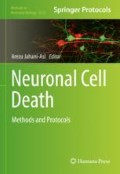Abstract
Understanding the mechanisms underlying the formation and progression of brain diseases is challenging due to the vast variety of involved genetic/epigenetic factors and the complexity of the environment of the brain. Current preclinical monolayer culture systems fail to faithfully recapitulate the in vivo complexities of the brain. Organoids are three-dimensional (3D) culture systems that mimic much of the complexities of the brain including cell–cell and cell–matrix interactions. Complemented with a theoretical framework to model the dynamic interactions between different components of the brain, organoids can be used as a potential tool for studying disease progression, transport of therapeutic agents in tissues, drug screening, and toxicity analysis. In this chapter, we first report on the fabrication and use of a novel self-filling microwell arrays (SFMWs) platform that is self-filling and enables the formation of organoids with uniform size distributions. Next, we will introduce a mathematical framework that predicts the organoid growth, cell death, and the therapeutic responses of the organoids to different therapeutic agents. Through systematic investigations, the computational model can identify shortcomings of in vitro assays and reduce the time and effort required to improve preclinical tumor models’ design. Lastly, the mathematical model provides new testable hypotheses and encourages mathematically driven experiments.
Access this chapter
Tax calculation will be finalised at checkout
Purchases are for personal use only
References
Seyfoori A, Amereh M, Dabiri SMH, Askari E, Walsh T, Akbari M (2021) The role of biomaterials and three dimensional (3D) in vitro tissue models in fighting against COVID-19. Biomater Sci 9:1217
Zhang B, Korolj A, Lai BFL, Radisic M (2018) Advances in organ-on-a-chip engineering. Nat Rev Mater 3:257–278
Lim M, Xia Y, Bettegowda C, Weller M (2018) Current state of immunotherapy for glioblastoma. Nat Rev Clin Oncol 15:422–442
Shojaei S, Koleini N, Samiei E, Aghaei M, Cole LK, Alizadeh J, Islam MI, Vosoughi AR, Albokashy M, Butterfield Y (2019) Simvastatin increases temozolomide-induced cell death by targeting the fusion of autophagosomes and lysosomes. FEBS J 287:1005
Stathias V, Jermakowicz AM, Maloof ME, Forlin M, Walters W, Suter RK, Durante MA, Williams SL, Harbour JW, Volmar C-H (2018) Drug and disease signature integration identifies synergistic combinations in glioblastoma. Nat Commun 9:1–13
Lin GL, Wilson KM, Ceribelli M, Stanton BZ, Woo PJ, Kreimer S, Qin EY, Zhang X, Lennon J, Nagaraja S (2019) Therapeutic strategies for diffuse midline glioma from high-throughput combination drug screening. Sci Transl Med 11:eaaw0064
Aoki Y, Hashizume R, Ozawa T, Banerjee A, Prados M, James CD, Gupta N (2012) An experimental xenograft mouse model of diffuse pontine glioma designed for therapeutic testing. J Neuro-Oncol 108:29–35
Duval K, Grover H, Han LH, Mou Y, Pegoraro AF, Fredberg J, Chen Z (2017) Modeling physiological events in 2D vs. 3D cell culture. Physiology (Bethesda) 32:266–277
Seyfoori A, Samiei E, Jalili N, Godau B, Rahmanian M, Farahmand L, Majidzadeh-A K, Akbari M (2018) Self-filling microwell arrays (SFMAs) for tumor spheroid formation. Lab Chip 18:3516–3528
Hubert CG, Rivera M, Spangler LC, Wu Q, Mack SC, Prager BC, Couce M, McLendon RE, Sloan AE, Rich JN (2016) A three-dimensional organoid culture system derived from human glioblastomas recapitulates the hypoxic gradients and cancer stem cell heterogeneity of tumors found in vivo. Cancer Res 76:2465–2477
Kim J, Koo B-K, Knoblich JA (2020) Human organoids: model systems for human biology and medicine. Nat Rev Mol Cell Biol 21:571–584
Kang SM, Kim D, Lee JH, Takayama S, Park JY (2021) Engineered microsystems for spheroid and organoid studies. Adv Healthc Mater 10:2001284
Zhu M, Li W, Dong X, Yuan X, Midgley AC, Chang H, Wang Y, Wang H, Wang K, Ma PX et al (2019) In vivo engineered extracellular matrix scaffolds with instructive niches for oriented tissue regeneration. Nat Commun 10:4620
Bassi G, Panseri S, Dozio SM, Sandri M, Campodoni E, Dapporto M, Sprio S, Tampieri A, Montesi M (2020) Scaffold-based 3D cellular models mimicking the heterogeneity of osteosarcoma stem cell niche. Sci Rep 10:22294
Trisilowati, Mallet DG (2012) In silico experimental modeling of cancer treatment. ISRN Oncol 2012:828701
Deisboeck TS, Zhang L, Yoon J, Costa J (2009) In silico cancer modeling: is it ready for prime time? Nat Clin Pract Oncol 6:34–42
Amereh M, Edwards R, Akbari M, Nadler B (2021) In silico modeling of tumor spheroid formation and growth. Micromachines 12:749
Byrne HM (2010) Dissecting cancer through mathematics: from the cell to the animal model. Nat Rev Cancer 10:221–230
Zhang L, Wang Z, Sagotsky JA, Deisboeck TS (2009) Multiscale agent-based cancer modeling. J Math Biol 58:545–559
Author information
Authors and Affiliations
Corresponding author
Editor information
Editors and Affiliations
Rights and permissions
Copyright information
© 2022 The Author(s), under exclusive license to Springer Science+Business Media, LLC, part of Springer Nature
About this protocol
Cite this protocol
Amereh, M., Seyfoori, A., Akbari, M. (2022). In Vitro Brain Organoids and Computational Models to Study Cell Death in Brain Diseases. In: Jahani-Asl, A. (eds) Neuronal Cell Death. Methods in Molecular Biology, vol 2515. Humana, New York, NY. https://doi.org/10.1007/978-1-0716-2409-8_17
Download citation
DOI: https://doi.org/10.1007/978-1-0716-2409-8_17
Published:
Publisher Name: Humana, New York, NY
Print ISBN: 978-1-0716-2408-1
Online ISBN: 978-1-0716-2409-8
eBook Packages: Springer Protocols

